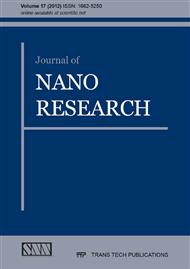[1]
W. Sun, C. R. Chenthamarakshan and K. Rajeshwar, Chronopotentiometry of titania film electrodes in aqueous media, J. Phys. Chem. B 106 (2002) 11531-11538.
DOI: 10.1021/jp020935x
Google Scholar
[2]
K. Rajeshwar and N. R. de Tacconi, Combustion Synthesis of Oxide Semiconductors for Solar Energy Conversion and Environmental Remediation, Chem. Soc. Rev. 38 (2009) 1984-(1998).
DOI: 10.1039/b811238j
Google Scholar
[3]
E. Nieuwlaar, E. Alsema, eds., Energy pay-back time (EPBT) and CO2 mitigation potential, Paper presented at: Environmental Aspects of PV Power Systems, IEA PVPS Task 1 Workshop, Utrecht, The Netherlands, June 25-27, (1997).
Google Scholar
[4]
L. H. Dall'Antonia, N. R. de Tacconi, W. Chanmanee, H. Timmaji, N. Myung and K. Rajeshwar, Electrosynthesis of bismuth vanadate photoelectrodes, Electrochem. Solid-State Lett. 13 (2010) D29-D32.
DOI: 10.1149/1.3322641
Google Scholar
[5]
N. Myung, S. Ham, S. Choi, Y. Chae, W-G. Kim, Y. J. Jeon, K. J. Paeng, W. Chanmanee, N. R. de Tacconi and K. Rajeshwar, Tailoring interfaces for electrochemical synthesis of semiconductor films: BiVO4, Bi2O3, or composites, J. Phys. Chem. C 115 (2011).
DOI: 10.1021/jp200632f
Google Scholar
[6]
H. K. Timmaji, W. Chanmanee, N. R. de Tacconi, and K. Rajeshwar, Solution combustion synthesis of BiVO4 nanoparticles: Effect of combustion precursors on the photocatalytic activity, J. Adv. Oxid. Technol. 14 (2011) 93.
DOI: 10.1515/jaots-2011-0112
Google Scholar
[7]
N. R. de Tacconi, H. K. Timmaji, W. Chanmanee, M. N. Huda, P. Sarker and K. Rajeshwar, Silver bismuth tungstate: Combustion synthesis, characterization, and use in the photocatalytic generation of syngas, submitted.
DOI: 10.1002/cphc.201200046
Google Scholar
[8]
K. Rajeshwar, Hydrogen generation at irradiated oxide semiconductor-solution interfaces, J. Appl. Electrochem. 37 (2007) 765-787.
DOI: 10.1007/s10800-007-9333-1
Google Scholar
[9]
K. Rajeshwar, Photoelectrochemistry and the environment, J. Appl. Electrochem. 25 (1995) 1067-1082.
Google Scholar
[10]
A. Walsh, Y. Yan, M. N. Huda, M. M. Al-Jassim and S. H. Wei, Band edge electronic structure of BiVO4: Elucidating the role of the Bi s and V d orbitals, Chemistry of Materials 21 (2009) 547-551.
DOI: 10.1021/cm802894z
Google Scholar
[11]
A. P. Finlayson, V. N. Tsaneva, L. Lyons, M. Clark and B. A. Glowacki, Evaluation of Bi–W-oxides for visible light photocatalysis, Phys. Stat. Solidi A 203 (2006) 327-335.
DOI: 10.1002/pssa.200521129
Google Scholar
[12]
D. A. Palmer and R. Van Eldik, The chemistry of metal carbonato and carbon dioxide complexes, Chemical Reviews 83 (1983) 651-731.
DOI: 10.1021/cr00058a004
Google Scholar
[13]
CRC Handbook of Chemistry and Physics; 82nd ed.; CRC Press: Boca Raton, FL, 2001-(2002).
Google Scholar
[14]
C. R. Chenthamarakshan and K. Rajeshwar, Photocatalytic reduction of divalent zinc and cadmium ions in aqueous TiO2 suspensions: An interfacial induced adsorption-reduction pathway mediated by formate ions, Electrochem. Commun. 2 (2000) 527-530.
DOI: 10.1016/s1388-2481(00)00078-3
Google Scholar


